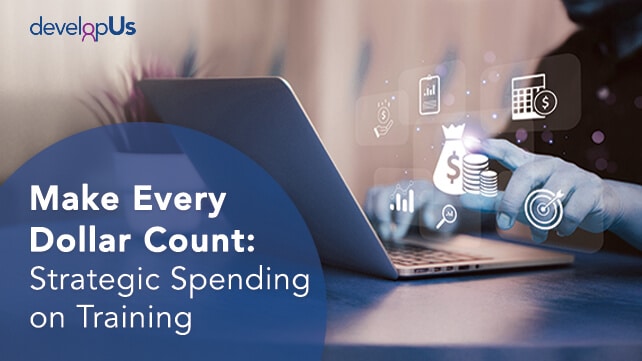How People Spend Training Dollars: Aligning Investments to How People Learn

In today’s rapidly evolving workplace, continuous learning and development are critical to employee performance, engagement, and retention. Companies that prioritize their workforce’s development not only see higher productivity but also cultivate a culture of innovation and loyalty.
Yet, many learning and development (L&D) executives find themselves questioning the most effective way to allocate training dollars. Are traditional training programs yielding the desired outcomes, or should investments shift toward more dynamic, employee-centered learning methods?
The 70-20-10 Learning Framework
Recent research reveals that how people learn can be broken into three primary categories:
- 10% Formal Training: Structured programs such as workshops, online courses, or classroom sessions.
- 20% Mentorship and Coaching: One-on-one or small group learning facilitated by experienced professionals.
- 70% On-the-Job Learning: Experiential, hands-on tasks and problem-solving within real-world scenarios.
This 70-20-10 framework, originally popularized by the Center for Creative Leadership, suggests that the majority of workplace learning happens outside formal training. Yet, many organizations continue to disproportionately allocate budgets toward formal training initiatives.
This blog explores how L&D executives can realign their training investments to better reflect these learning percentages, enhancing employee development and maximizing training ROI.
The Importance of Development for Performance, Engagement, and Retention
Investing in employee development isn’t just a “nice-to-have”—it’s a business imperative. Studies consistently show that organizations with strong learning cultures outperform their peers. Why? Because learning drives three key outcomes:
- Improved Performance: Employees equipped with the right skills are more effective in their roles. They can adapt to changing circumstances, solve problems efficiently, and innovate within their domains.
- Enhanced Engagement: Employees who feel supported in their growth are more engaged. Engagement leads to increased job satisfaction, reduced absenteeism, and higher levels of discretionary effort.
- Stronger Retention: Development opportunities are a top driver of employee retention. When employees believe they can advance their careers within an organization, they are less likely to look elsewhere.
With this foundation in mind, let’s explore each component of the 70-20-10 model and its implications for training budgets.
Formal Training: The 10%
Formal training accounts for only 10% of workplace learning but remains an essential component of employee development. This type of learning provides foundational knowledge and skills in a structured environment. Examples include:
- Instructor-led workshops on technical skills like coding or data analysis
- Online courses or certifications in project management or marketing strategies
- Compliance training required for regulatory standards
While formal training is vital for establishing baseline competencies, its structured nature can sometimes limit its impact. Employees may struggle to retain or apply knowledge without immediate opportunities to practice.
For this reason, formal learning should be integrated with other learning methods to reinforce application and retention.
Benefits of Formal Training
- Provides employees with a standardized foundation
- Enables scalability, reaching large groups of employees simultaneously
- Ideal for technical or compliance-based skill development
How to Optimize Spend on Formal Training
To ensure formal training delivers maximum value, L&D leaders should:
- Prioritize high-quality, relevant content tailored to specific employee needs
- Incorporate interactive elements, such as simulations or group activities
- Pair formal training with follow-up mentoring or on-the-job tasks
Mentorship and Coaching: The 20%
Mentorship and coaching play a critical role in learning, accounting for 20% of workplace development. Through personal interactions, employees gain tailored guidance, feedback, and support. Examples include:
- One-on-one coaching sessions with a manager or external coach
- Peer mentoring programs where experienced employees guide newer hires
- Group coaching focused on leadership development or team collaboration
Mentors and coaches provide a bridge between theory and application, helping employees navigate role-specific challenges. The personalized nature of this approach fosters deeper connections and long-term professional growth.
Benefits of Mentorship and Coaching
- Encourages personalized feedback and problem-solving
- Builds trust and strengthens professional relationships
- Helps develop soft skills like communication, emotional intelligence, and leadership
How to Optimize Spend on Mentorship and Coaching
To amplify the impact of mentorship and coaching:
- Create formal mentoring programs with clear goals and guidelines
- Train managers to adopt a coaching mindset
- Use tech platforms to match mentors and mentees based on skills and career goals
On-the-Job Learning: The 70%
The majority of employee learning happens through hands-on experiences. On-the-job learning, which accounts for 70% of development, occurs as employees tackle real-world challenges. Examples include:
- Stretch assignments that push employees beyond their comfort zones
- Cross-functional projects that expose them to new parts of the business
- Job shadowing or rotational programs that develop broader perspectives
This method is highly effective because it allows employees to immediately apply what they’ve learned, boosting both retention and confidence.
Benefits of On-the-Job Learning
- Promotes immediate application of skills
- Encourages problem-solving and innovation
- Develops ownership and accountability
How to Optimize Spend on On-the-Job Learning
To enhance on-the-job learning:
- Foster a culture of experimentation and continuous feedback
- Provide learning tools like job aids or microlearning modules
- Create clear career progression pathways based on hands-on experience
Realigning Training Dollars to Reflect Learning Realities
To align training budgets with the 70-20-10 framework, L&D executives must take a strategic approach:
- Audit Current Spend: Analyze how much of the current training budget goes toward formal programs versus mentoring and on-the-job learning. Identify areas of misalignment.
- Shift Investments Strategically: Reallocate funds to emphasize mentorship and experiential learning. For example:
- Reduce the frequency of generic workshops in favor of targeted coaching initiatives.
- Invest in tools that facilitate collaborative learning and real-time feedback.
- Measure Impact: Track key performance indicators (KPIs) such as skill acquisition, employee engagement, and retention rates to evaluate the effectiveness of each training method.
- Communicate Value: Help stakeholders understand the rationale for budget adjustments by linking learning initiatives to business outcomes like revenue growth, customer satisfaction, and innovation.
Conclusion
Training dollars are one of the most powerful tools organizations have for driving employee development and business success. However, to truly unlock their potential, L&D leaders must align investments with the way people learn. By embracing the 70-20-10 framework, organizations can create a balanced, impactful approach to training that combines the strengths of formal education, mentorship, and experiential learning.
When employees receive the right mix of learning opportunities, they don’t just grow in their roles—they thrive. And when employees thrive, so do the organizations they serve. It’s time to rethink training investments and build a future-ready workforce, one learning moment at a time.




Leave a Reply